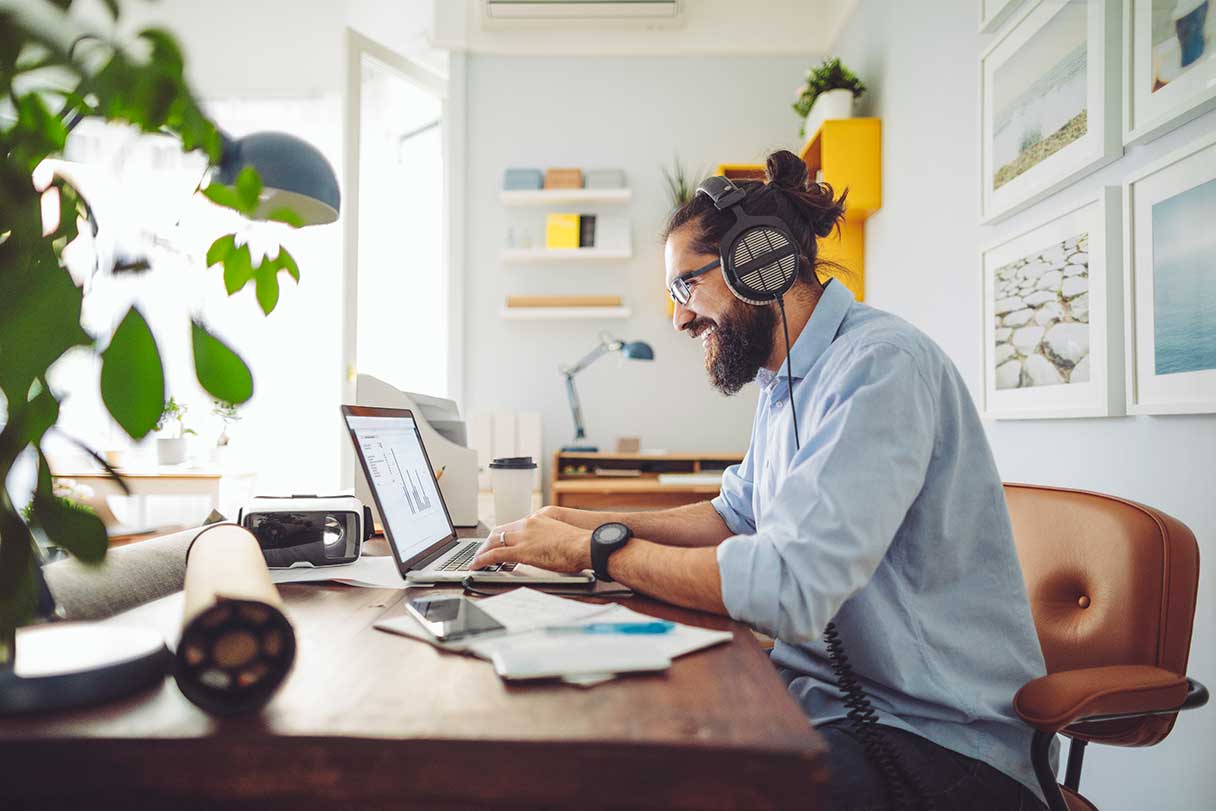Headphones and earbuds are popular tools for listening to music, podcasts and audiobooks. But some experts believe the increased use of these listening devices may be partly to blame for an increase in hearing loss. The rate of hearing loss among today’s teens, for example, is about 30% higher than it was 20 years ago.1
While noise-induced hearing loss is generally preventable, more than 1 billion people aged 12 to 35 risk hearing loss due to excessive exposure to loud noises, including noise from headphones and earbuds.2
How Headphones and Earbuds Can Affect Hearing
The auditory pathway is complex. Sound waves from our environment are translated from vibrations to electrical signals by traveling through our outer ear, middle ear and inner ear and then onto the nerve that takes the signal to the brain.3
A big part of this translation involves the tiny hair cells that line the inner ear. Damage to these hair cells can cause permanent hearing loss.3
Wearing headphones and earbuds consistently at 85 decibels or above can cause permanent damage to hair cells that are key in getting sound signals to the brain.3
For context, a normal conversation is 60 to 70 decibels. Examples of sounds that are 85 decibels or more3 can include:
- Food blenders
- Loud movie theaters
- Motorcycles and dirt bikes
- Noisy restaurants
- Power tools
Headphones vs. earbuds
A common myth is that earbuds are more harmful to your ears than headphones, mainly because an earbud sits directly next to your eardrum. However, the risk of hearing loss lies not in the proximity to the ear but in the volume of your device.4
Both earbuds and headphones can be equally safe to use as long as you control the volume.4
Common Signs of Noise-Induced Hearing Loss
Depending on whether it is acute or chronic, noise-induced hearing loss can come on suddenly or slowly progress over a period of time. Oftentimes, you might not notice anything is wrong until it becomes more pronounced.3
Some warning signs of hearing loss to look out for include:3
- A need to turn up the volume on the TV or your audio device
- Difficulty understanding people when they talk
- Distorted or muffled hearing
- Tinnitus (ringing in the ears)
- Trouble hearing in noisy environments
Detecting hearing loss early is key to preventing it from progressing. Untreated hearing loss has a multitude of health consequences, including a higher potential for:5
- Anxiety
- Balance issues
- Cardiovascular disease
- Cognitive decline
- Increased risk of falling
- Persistent ringing in the ears
- Social isolation and depression
Tips to Prevent Hearing Loss From Headphones
The key to protecting your hearing while wearing headphones or earbuds is volume and time control — too loud and too long can strain the delicate hair cells that are crucial for hearing. A common tip is to use the 60/60 rule: Listen to your device at 60% volume for no more than 60 minutes at a time.6
There are other ways to protect your hearing while wearing headphones or earbuds:
1. Take listening breaks
Listening to audio on our devices is part of everyday life for some people, but taking regular breaks can give our ears a rest and a chance to recover.4
2. Use noise-canceling headphones
We often turn up the volume on our devices to block out surrounding noise from the environment. Using noise-canceling headphones is a great way to block out this noise while keeping the volume low, protecting your ears from damage.4
3. Pay attention to volume warnings
Smartphones and devices with audio may come with warning notifications when the volume gets too loud. Take advantage of the technology and use the settings provided to limit the volume.6
4. Clean your equipment
Using a soft cloth or alcohol wipe to clean your headphones and earbuds is a great way to protect your ears from possible infection, as bacteria, dirt and earwax can be contaminants.6
5. Use a speaker if available
If available, using the speaker on your computer or phone instead of headphones is a good way to give your ears a break while still enjoying your audio content.6
Headphone Setting Recommendations
Headphones and earbuds will let you turn up the volume well past 85 decibels, which is when hearing damage can start.7
The good news is that smartphones have alerts and apps that you can use to make sure your volume doesn’t get to dangerous levels.7
Volume control for kids and teens
It is a good rule of thumb to put controls and limits on children’s phones and devices to protect their hearing while using headphones and earbuds.8
Using the settings and apps on the phone can help you set parameters on how loud they can turn up the volume. You can also protect these limits using a PIN code to ensure they do not change the settings.9
Protecting Hearing in Noisy Environments
Wearing headphones and earbuds to listen to music or other audio content while out and about is common for some people. However, in noisy environments, the volume may be turned up to dangerous levels to drown out the background noise.10
Here are some tips on how to protect your hearing in noisy environments:10
- Avoid turning up the volume too loud
- Find a quiet place to listen, if possible
- Use noise-canceling headphones
- Wear hearing protectors (earplugs, protective earmuffs) when attending loud events or working with loud machinery.
Setting Good Habits Early
Since the use of audio devices may be a part of everyday life and culture, it is important to be mindful of how we use them in order to prevent damage to our hearing. Setting early habits and modeling good listening behavior for children and teens can be key to helping prevent hearing loss while wearing headphones and earbuds.
Some tips on setting good habits include:11
- Encourage frequent listening breaks
- Talk to your children about the risks of noise-induced hearing loss
- Set volume controls on your children’s devices
- Use noise-canceling headphones
- Use speakers instead of headphones to listen to audio when possible
When to See a Hearing Specialist
If you or a loved one is having signs or symptoms of hearing loss, it is important to get your hearing checked by an ear, nose, and throat (ENT) doctor, an audiologist or a hearing specialist.
A simple pure tone hearing test can help diagnose the type of hearing loss and its severity. Hearing aids are a common treatment for hearing loss.11
For children, hearing screening is typically routine at annual pediatrician visits, and it’s also done at certain grade levels at school.12
Protect Your Hearing
The bottom line is that using headphones or earbuds to listen to our audio devices too loudly for too long can cause noise-induced hearing loss. Following precautions such as the 60/60 rule, taking frequent listening breaks and setting volume controls on phones and devices can help keep your hearing safe and keep you listening.
Frequently Asked Questions
Have more questions about how headphones and earbuds can impact hearing loss? Here are some answers to commonly asked questions on this topic.
Financing Ear Care With the CareCredit Credit Card
The CareCredit credit card can help you pay for hearing care, including regular hearing tests, screenings and more.* Use our Acceptance Locator to find a hearing specialist near you that accepts CareCredit. Continue to invest in your wellness journey by downloading the CareCredit Mobile App to manage your account, find a provider on the go and easily access the Well U blog for more great articles, podcasts and videos.
In addition to hearing care, you can also use your CareCredit credit card for dentistry, cosmetic, pet care, vision, health systems, dermatology, pharmacy purchases, spa treatments and so much more within the CareCredit network. How will you invest in your health and wellness next?
Author Bio
Amy Isler, M.S.N., R.N., has more than a decade of nursing expertise. She combines her nursing experience and journalism background to create engaging and educational healthcare content for leading brands and publications, including GoodRx, Verywell Health, Vision Center and more. Her mission in writing is to provide positive, accurate and informative articles for consumers.







